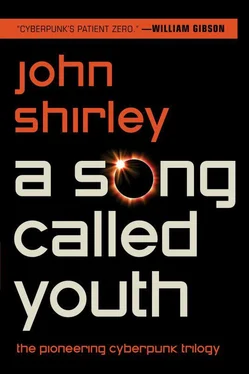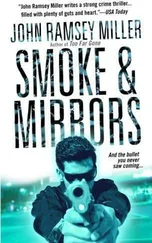Rickenharp had never colored or shaped his hair, except to encourage its punk spikiness.
But Rickenharp wasn’t a punkrocker. He identified with prepunk, late 1950s, mid-1960s, early 1970s. Rickenharp was a proud anachronism. He was simply a hard-core rocker, as out of place in the Semiconductor as bebop would have been in the 1980s dance clubs.
Rickenharp looked around at the flat-back, flat-gray, monochrome tunics and jumpsuits, the black wristfones, the cookie-cutter sameness of JAS’s; at the uniform tans and ubiquitous FirStep Colony-shaped earrings (only one, always in the left ear). The high-tech-fetishist minimonos were said to aspire toward a place in the Colony the way Rastas had dreamed of a return to Ethiopia. Rickenharp thought it was funny that the Russians had blockaded the Colony. Funny to see the normally dronelike, antiflamboyant minimonos quietly simmering on ampheticool, standing in tense groups, hissing about the Russian blockade of FirStep, in why-doesn’t-someone-do-something outrage.
The stultifying regularity of their canned music banged from the walls and pulsed from the floor. Lean against the wall and you felt a drill-bit vibration of it in your spine.
There were a few hardy, defiant flares here, and flares were Rickenharp’s best hope for getting laid. They tended to respect old rock.
The music ceased; a voice boomed, “Joel NewHope!” and spots hit the stage. The first wifi act had come on. Rickenharp glanced at his watch. It was ten. He was due to open for the headline act at 11:30. Rickenharp pictured the club emptying as he hit the stage. He wasn’t long for this club.
NewHope hit the stage. He was anorexic and surgically sexless: radical minimono. A fact advertised by his nudity: he wore only gray and black spray-on sheathing, his dick in a drag queen’s tuck. How did the guy piss? Rickenharp, wondered. Maybe it was out of that faint crease at his crotch. A dancing mannequin. His sexuality was clipped to the back of his head: a single chrome electrode that activated the pleasure center of the brain during the weekly legally controlled catharsis. But he was so skinny—hey, who knows, maybe he went to a black-market cerebrostim to interface with the pulser. Though minimonos were supposed to be into stringent law and order.
The neural transmitters jacked into NewHope’s arms and legs and torso transmitted to pickups on the stage floor. The long, funereal wails pealing from hidden speakers were triggered by the muscular contractions of his arms and legs and torso. He wasn’t bad, for a minimono, Rickenharp thought. You can make out the melody, the tune shaped by his dancing, and it had a shade more complexity than the M’n’Ms usually had… The M’n’M crowd moved into their geometrical dance configurations, somewhere between disco dancing and square dance, Busby Berkley kaleidoscopings worked out according to formulas you were simply expected to know, if you had the nerve to participate. Try to dance freestyle in their interlocking choreography, and sheer social rejection, on the wings of body language, would hit you like an arctic wind.
Sometimes Rickenharp did an acid dance in the midst of the minimono configuration, just for the hell of it, just to revel in their rejection. But his band had made him stop that. Don’t alienate the audience at our only gig, man. Probably our last fucking gig…
The wiredancer rippled out bagpipelike riffs over the digitalized rhythm section. The walls came alive.
A good rock club—in 1965 or 1975 or 1985 or 1995 or 2012 or 2039 should be narrow, dark, close, claustrophobic. The walls should be either starkly monochrome—all black or mirrored, say—or deliberately garish. Camp, layered with whatever was the contemporary avant-garde or gaudy graffiti.
The Semiconductor showed both sides. It started out butch, its walls glassy black; during the concert it went in gaudy drag as the sound-sensitive walls reacted to the music with color streaking, wavelengthing in oscilloscope patterns, shades of blue-white for high end, red and purple for bass and percussion, reacting vividly, hypnotically to each note. The minimonos disliked reactive walls. They called it kitschy.
The dance spazzed the stage, and Rickenharp grudgingly watched, trying to be fair to it. Thinking, It’s another kind of rock ’n’ roll, is all. Like a Christian watching a Buddhist ceremony, telling himself, “Oh, well, it’s all manifestations of the One God in the end.” Rickenharp thinking: But real rock is better. Real rock is coming back, he’d tell almost anyone who’d listen. Almost no one would.
A chaotichick came in, and he watched her, feeling less alone. Chaotics were much closer to real rockers. She was a skinhead, with the sides of her head painted. The Gridfriend insignia was tattooed on her right shoulder. She wore a skirt made of at least two hundred rags of synthetic material sewn to her leather belt—a sort of grass skirt of bright rags. The nipples of her bare breasts were pierced with thin screws. The minimonos looked at her in disgust; they were prudish, and calling attention to one’s breasts was decidedly gauche with the M’n’Ms. She smiled sunnily back at them. Her handsome Semitic features were slashed randomly with paint. Her makeup looked like a spinpainting. Her teeth were filed.
Rickenharp swallowed hard, looking at her. Damn. She was his type.
Only… she wore a blue-mesc sniffer. The sniffer’s inverted question mark ran from its hook at her right ear to just under her right nostril. Now and then she tilted her head to it, and sniffed a little blue powder.
Rickenharp had to look away. Silently cursing.
He’d just written a song called “Stay Clean.”
Blue mesc. Or syncoke. Or heroin. Or amphetamorphine. Or XTZ. But mostly he went for blue mesc. And blue mesc was addictive.
Blue mesc, also called boss blue. It offered some of the effects of mescaline and cocaine together, framed in the gelatinous sweetness of methaqualone. Only… stop taking it after a period of steady use and the world drained of meaning for you. There was no actual withdrawal sickness. There was only a deeply resonant depression, a sense of worthlessness that seemed to settle like dust and maggot dung into each individual cell of the user’s body.
Some people called blue mesc “the suicide ticket.” It could make you feel like a coal miner when the mineshaft caved in, only you were buried in yourself.
Rickenharp had squandered the money from his only major microdisc hit on boss blue and synthmorph. He’d just barely made it clean. And lately, at least before the band squabbles, he’d begun feeling like life was worth living again.
Watching the girl with the sniffer walk past, watching her use, Rickenharp felt stricken, lost, as if he’d seen something to remind him of a lost lover. An ex-user’s syndrome. Pain from guilt of having jilted your drug.
And he could imagine the sweet burn of the stuff in his nostrils, the backward-sweet pharmaceutical taste of it in the back of his palate; the rush; the autoerotic feedback loop of blue mesc. Imagining it, he had a shadow of the sensation, a tantalizing ghost of the rush. In memory he could taste it, smell it, feel it… Seeing her use brought back a hundred iridescent memories and with them came an almost irrepressible longing. (While some small voice in the back of his head tried to get his attention, tried to warn him, Hey, remember the shit makes you want to kill yourself when you run out; remember it makes you stupidly overconfident and boorish; remember it eats your internal organs … a small, dwindling voice… )
The girl was looking at him. There was a flicker of invitation in her eyes.
He wavered.
The small voice got louder.
Rickenharp, if you go to her, go with her, you’ll end up using.
Читать дальше












